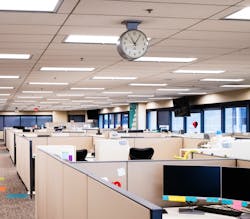Lighting contractor EMC (Energy Management Collaborative), Bluetooth software specialist Silvair, and modular connectivity innovator McWong have revealed what may be the largest Bluetooth mesh connected lighting installation to date. A 22-story, 470,317-ft2 office building in Minnesota has been retrofitted top to bottom with connected LED luminaires using a so-called LLLC (luminaire-level lighting control) approach where each luminaire has an integrated wireless controller and sensor. The partners in the project believe the connectivity will add 75% in savings over and above the savings achievable through a baseline solid-state lighting (SSL) retrofit. Moreover, the installation opens the door for the addition of IoT (Internet of Things) applications such as office space optimization.
Still, it’s the scope of the project that stands out. In the early days of Bluetooth mesh, we wrote several times that proponents were struggling to connect more than a few hundred nodes on a single network. Silvair had insisted the technology was simply going through a maturation phase. The company had been a key contributor in developing the standard and contributed several articles on the top to our publication. Most recently, we published details of a technical Q&A session on the benefits of Bluetooth mesh following a webcast.
The Minnesota project certainly proves out many of the claims made by Bluetooth mesh proponents. EMC installed 3685 luminaires in a one-for-one retrofit of existing lighting. And later EMC upgraded an additional 225 luminaires in common areas such as elevator lobbies with Bluetooth nodes. And all of those luminaires are connected in a single Bluetooth mesh network with no gateways required. The building does serve many tenants. So the new lighting has been commissioned and organized into 43 separate control areas with a total of 708 control zones. So each tenant has control of their own space.
The LLLC concept is key to maximizing energy savings beyond what LEDs deliver with baseline autonomous control of the lighting. In September 2020, the NEEA (Northwest Energy Efficiency Alliance) and the DLC (DesignLights Consortium) published a study on the benefits of LLLC and said at the time that the control technology could deliver an additional 70% in savings.
In this office project, the 3685 new luminaires installed had integrated McWong TruBlu Mesh Sensors — specifically the Model PSC-BL-I-RD-DCO-BLE-SR. That products includes a control/communications module and a cable-connected sensor unit. The sensor is mounted on the downward-facing surface of the luminaire and includes both occupancy and ambient light sensing capabilities. The control module also uses a 0-10V link to set the driver output level. Out of the box, the luminaires can implement autonomous control based on people in the space and natural light through the windows. McWong uses Silvair’s software stack in the TruBlu products.
The team was able to configure the entire network using McWong’s TruBlu web application offsite and prior to installation of the project. The team could preconfigure each zone for response to occupancy, vacancy, and/or programmatic schedule. Moreover any zone could be set to manual control. Once the project was installed, final commissioning was handled with McWong’s TruBlu commissioning tool.
Of course, the cost of such LLLC projects will always be an issue. EMC, Silvair, and McWong did not provide any return on investment (ROI) projections for the Minnesota project. But if the system delivers on the projected energy savings, the ROI should pencil out just fine. The NEEA has recently published research on the cost premium of LLLC. That research breaks the implementation of LLLC technology into categories based on complexity. We’d suspect that the Minnesota installation might fall in the clever range where the NEEA said adding the controls cost $1.85/ft2.
Still, the Minnesota project could clearly be upgraded to a full IoT installation in the future without having to change the technology installed in the LED luminaires. But other network hardware and system control capability would be required to add an application such as space optimization or to move toward smart buildings and HVAC control.
LEDs Magazine chief editor MAURY WRIGHT is an electronics engineer turned technology journalist, who has focused specifically on the LED & Lighting industry for the past decade.
For up-to-the-minute LED and SSL updates, why not follow us on Twitter? You’ll find curated content and commentary, as well as information on industry events, webcasts, and surveys on our LinkedIn Company Page and our Facebook page.





